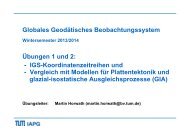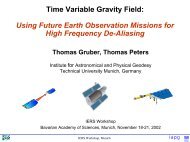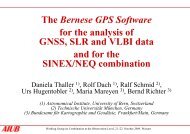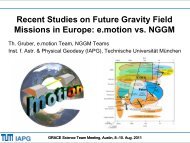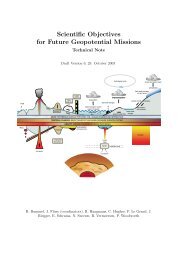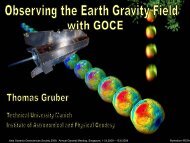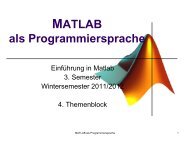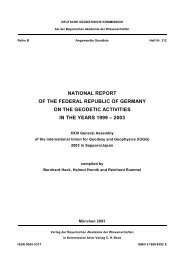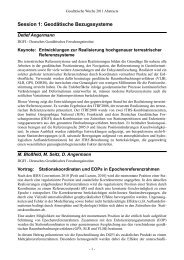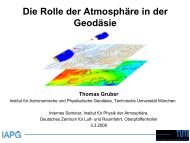quicklook gravity field solutions as part of the goce quality ... - TUM
quicklook gravity field solutions as part of the goce quality ... - TUM
quicklook gravity field solutions as part of the goce quality ... - TUM
You also want an ePaper? Increase the reach of your titles
YUMPU automatically turns print PDFs into web optimized ePapers that Google loves.
QUICKLOOK GRAVITY FIELD SOLUTIONS AS PART OF THE GOCE QUALITY<br />
ASSESSMENT<br />
Reinhard Mayrh<strong>of</strong>er (1) , Roland Pail (2) , Thom<strong>as</strong> Fecher (2)<br />
(1) Graz University <strong>of</strong> Technology, Institute <strong>of</strong> Navigation and Satellite Geodesy, Steyrerg<strong>as</strong>se 30, 8010 Graz,<br />
Email: reinhard.mayrh<strong>of</strong>er@tugraz.at<br />
(2) Technical University Munich, Institute <strong>of</strong> Astronomical and Physical Geodesy, Arcisstraße 21, 80333 Munich,<br />
Email: pail@bv.tum.de<br />
ABSTRACT<br />
The Quick-Look Gravity Field Analysis (QL-GFA) is a<br />
component <strong>of</strong> <strong>the</strong> Routine & Rapid Processing Facilities<br />
in <strong>the</strong> framework <strong>of</strong> <strong>the</strong> ESA-funded project “GOCE<br />
High-level Processing Facility”, an operational<br />
hardware and s<strong>of</strong>tware system for <strong>the</strong> scientific<br />
processing <strong>of</strong> GOCE data, in order to derive a spherical<br />
harmonic Earth’s <strong>gravity</strong> <strong>field</strong> model from <strong>the</strong> GOCE<br />
orbits b<strong>as</strong>ed on satellite-to-satellite tracking (SST) in<br />
high-low mode, and satellite <strong>gravity</strong> gradiometry (SGG)<br />
data with very short latencies. Thus with <strong>the</strong> QL-GFA it<br />
is possible to monitor <strong>the</strong> <strong>quality</strong> <strong>of</strong> <strong>the</strong> input data and to<br />
derive a f<strong>as</strong>t diagnosis <strong>of</strong> <strong>the</strong> GOCE system<br />
performance on <strong>gravity</strong> <strong>field</strong> model level. The QL-GFA<br />
is b<strong>as</strong>ed on a semi-analytic approach, applying F<strong>as</strong>t<br />
Fourier Transform techniques to derive <strong>gravity</strong> <strong>field</strong><br />
models within a few hours <strong>of</strong> computation time. Key<br />
products are <strong>gravity</strong> <strong>field</strong> models <strong>as</strong> SGG-only, SSTonly,<br />
and combined <strong>solutions</strong>, <strong>as</strong> well <strong>as</strong> estimates <strong>of</strong><br />
<strong>the</strong> gradiometer error power spectral density computed<br />
from <strong>the</strong> residuals <strong>of</strong> a SGG-only <strong>gravity</strong> <strong>field</strong> analysis.<br />
1. INTRODUCTION<br />
The scientific GOCE data processing (Level 1b to<br />
Level 2) is performed by <strong>the</strong> “European GOCE Gravity<br />
Consortium” (EGG-C), a consortium <strong>of</strong> 10 European<br />
university and research institutes, in <strong>the</strong> framework <strong>of</strong><br />
<strong>the</strong> ESA-funded project “GOCE High-Level Processing<br />
Facility” ([16]). In addition to <strong>the</strong> production <strong>of</strong> precise<br />
GOCE orbits, calibrated <strong>gravity</strong> gradients and a highaccuracy,<br />
high-resolution GOCE spherical harmonic<br />
model <strong>of</strong> <strong>the</strong> Earth’s <strong>gravity</strong> <strong>field</strong> including variancecovariance<br />
information (in a post-processing step), one<br />
component <strong>of</strong> HPF deals with <strong>the</strong> generation <strong>of</strong> <strong>quicklook</strong><br />
products (rapid science orbits, approximate <strong>gravity</strong><br />
<strong>field</strong> models) already in parallel to <strong>the</strong> GOCE<br />
me<strong>as</strong>urement ph<strong>as</strong>es. The main purpose <strong>of</strong> <strong>the</strong>se <strong>quicklook</strong><br />
products is to derive a f<strong>as</strong>t diagnosis <strong>of</strong> <strong>the</strong> GOCE<br />
sensor systems, and thus to contribute to ESA’s<br />
calibration and validation activities. In <strong>the</strong> frame <strong>of</strong> this<br />
HPF contract, <strong>the</strong> “Sub-processing Facility (SPF)<br />
6000”, a co-operation <strong>of</strong> TU Graz, Austrian Academy <strong>of</strong><br />
Sciences, University <strong>of</strong> Bonn, and TU Munich, under<br />
<strong>the</strong> lead <strong>of</strong> TU Graz, is − in addition to <strong>the</strong> production<br />
<strong>of</strong> a high-precision GOCE <strong>gravity</strong> <strong>field</strong> model − also<br />
_________________________________________________<br />
Proc. ‘ESA Living Planet Symposium’, Bergen, Norway<br />
28 June – 2 July 2010 (ESA SP-686, December 2010)<br />
responsible for <strong>the</strong> processing <strong>of</strong> quick-look <strong>gravity</strong><br />
<strong>field</strong> models from preliminary GOCE orbit data<br />
applying satellite-to-satellite tracking in <strong>the</strong> high-low<br />
mode (hl-SST), and satellite <strong>gravity</strong> gradiometry (SGG),<br />
cf. [8].<br />
2. KEY TASKS OF QL-GFA<br />
Key t<strong>as</strong>ks <strong>of</strong> QL-GFA are:<br />
• Check <strong>of</strong> SGG and hl-SST input data in parallel to<br />
<strong>the</strong> mission and analysis <strong>of</strong> <strong>part</strong>ial / incomplete<br />
SGG and hl-SST data sets.<br />
• Computation <strong>of</strong> quick-look <strong>gravity</strong> <strong>field</strong> models<br />
(SST-only, SGG-only, combined SST+SGG) for <strong>the</strong><br />
purpose <strong>of</strong> a f<strong>as</strong>t analysis <strong>of</strong> <strong>the</strong> information content<br />
<strong>of</strong> <strong>the</strong> input data on <strong>the</strong> level <strong>of</strong> <strong>the</strong> <strong>gravity</strong> <strong>field</strong><br />
solution.<br />
• Delivery <strong>of</strong> near real-time <strong>gravity</strong> <strong>field</strong> <strong>solutions</strong><br />
(QL-A) and high resolution <strong>gravity</strong> <strong>field</strong> models<br />
with short latencies <strong>of</strong> below 4 days (QL-B).<br />
• Estimation <strong>of</strong> <strong>the</strong> gradiometer error PSD (power<br />
spectral density) from <strong>the</strong> residuals <strong>of</strong> a SGG-only<br />
<strong>gravity</strong> <strong>field</strong> analysis.<br />
• Quality analysis: Hypo<strong>the</strong>sis testing <strong>of</strong> derived<br />
coefficient <strong>solutions</strong> and statistical error estimates<br />
against prior models.<br />
• Production <strong>of</strong> Quality Report Sheets.<br />
QL-GFA is applied at two stages: Quick-Look-A<br />
(QL-A) is applied to Level 1b preliminary orbits<br />
(SST_POS_2C, accuracy ~10 m) and <strong>the</strong> Level 1b<br />
<strong>gravity</strong> gradients (EGG_GGT_2C). The main purpose at<br />
this stage is a rough check <strong>of</strong> <strong>the</strong> SGG me<strong>as</strong>urement<br />
time series, with special emph<strong>as</strong>is on <strong>the</strong> evaluation <strong>of</strong><br />
<strong>the</strong> SGG error PSD. For QL-A, consecutive <strong>gravity</strong> <strong>field</strong><br />
<strong>solutions</strong> are available in a daily interval. They are<br />
generated with a latency <strong>of</strong> 4 hours after arrival <strong>of</strong> all<br />
required input data.<br />
Quick-Look-B (QL-B) is applied after <strong>the</strong> availability <strong>of</strong><br />
<strong>the</strong> Level 2 rapid science orbit solution (accuracy in <strong>the</strong><br />
decimetre range, SST_RSO_2) and <strong>the</strong> calibrated<br />
<strong>gravity</strong> gradients (EGG_NOM_2I). For QL-B,<br />
consecutive <strong>gravity</strong> <strong>field</strong> <strong>solutions</strong> are available in a
weekly interval. The maximum degree and order for <strong>the</strong><br />
QL-GFA <strong>gravity</strong> <strong>field</strong> models are optimized with<br />
respect to <strong>the</strong> global coverage <strong>of</strong> <strong>the</strong> input data, and are<br />
now in <strong>the</strong> range between degree/order 160 to 185.<br />
Additionally to <strong>the</strong> regular processing <strong>of</strong> weekly<br />
<strong>solutions</strong>, also a high resolution <strong>gravity</strong> <strong>field</strong> model h<strong>as</strong><br />
been computed from two months <strong>of</strong> cycle-1<br />
(November/December 2009) data with a resolution <strong>of</strong><br />
degree/order 200.<br />
3. FUNCTIONAL MODEL<br />
The QL-GFA is b<strong>as</strong>ed on <strong>the</strong> semi-analytic approach.<br />
While in <strong>the</strong> direct, time-wise and space-wise solution<br />
strategies ([2], [8], and [7], respectively), <strong>the</strong><br />
observations are regarded <strong>as</strong> functions <strong>of</strong> <strong>the</strong><br />
geographical location (r,ϑ,λ), <strong>the</strong>y can also be<br />
considered <strong>as</strong> a periodic time-series for one repeat<br />
period ([15]). Assuming a circular orbit, <strong>the</strong><br />
gravitational potential V and also derived <strong>gravity</strong><br />
functionals V (κ) can be rewritten <strong>as</strong> a Fourier series<br />
= m k<br />
( κ )<br />
( κ )<br />
[ A cosψ<br />
( t)<br />
B sinψ<br />
( t ]<br />
( κ )<br />
V ( t)<br />
∑∑ +<br />
) (1)<br />
km<br />
where ψkm(t) is related to <strong>the</strong> two fundamental<br />
frequencies ωo (satellite orbit revolution) and ωe (Earth's<br />
rotation). The spherical harmonic coefficients Clm, Slm <strong>of</strong><br />
<strong>the</strong> same order m are lumped toge<strong>the</strong>r in a linear way to<br />
compose <strong>the</strong> Fourier coefficients Alm (κ) and Blm (κ) ([15]),<br />
leading to a block-diagonal structure <strong>of</strong> <strong>the</strong><br />
corresponding normal equation matrix. More details on<br />
<strong>the</strong> QL-GFA functional model and s<strong>of</strong>tware strategy can<br />
be found in [10], [11], [12] and [13].<br />
QL-GFA <strong>solutions</strong> complete to degree/order 250 can be<br />
processed within one to two hours on a standard PC.<br />
The efficiency and speed <strong>of</strong> QL-GFA is founded mainly<br />
on <strong>the</strong> application <strong>of</strong> FFT techniques, a simplified filter<br />
strategy in <strong>the</strong> spectral domain to cope with <strong>the</strong><br />
coloured noise characteristics <strong>of</strong> <strong>the</strong> gradiometer, and<br />
<strong>the</strong> <strong>as</strong>sumption <strong>of</strong> block-diagonality <strong>of</strong> <strong>the</strong> normal<br />
equation matrix. Deviations from this <strong>as</strong>sumption are<br />
incorporated by means <strong>of</strong> an iterative procedure.<br />
A detailed discussion <strong>of</strong> <strong>the</strong> <strong>the</strong>ory and <strong>the</strong><br />
ma<strong>the</strong>matical models <strong>of</strong> <strong>the</strong> QL-GFA s<strong>of</strong>tware can be<br />
found in [9].<br />
4. SOFTWARE ARCHITECTURE<br />
Fig. 1 shows <strong>the</strong> architectural design, <strong>the</strong> main<br />
components and <strong>the</strong> product flow through <strong>the</strong> QL-GFA<br />
s<strong>of</strong>tware system.<br />
km<br />
km<br />
km<br />
Figure 1. QL-GFA: Architectural design and product<br />
flow<br />
In <strong>the</strong> following, <strong>the</strong> main modules shall be briefly<br />
described.<br />
Input:<br />
In <strong>the</strong> c<strong>as</strong>e <strong>of</strong> QL-A processing, exclusively Level 1b<br />
data and several auxiliary data products are used. In this<br />
s<strong>of</strong>tware mode, <strong>the</strong> start <strong>of</strong> <strong>the</strong> processing is fully<br />
automated. It is checked in regular intervals whe<strong>the</strong>r<br />
new data have arrived via <strong>the</strong> <strong>of</strong>ficial HPF interface, <strong>the</strong><br />
processing is started and operated automatedly until <strong>the</strong><br />
delivery <strong>of</strong> <strong>the</strong> QL-GFA output products again via <strong>the</strong><br />
<strong>of</strong>ficial interface.<br />
In <strong>the</strong> c<strong>as</strong>e <strong>of</strong> QL-B processing, Level 1b data (e.g.,<br />
attitude information, accelerometry data), Level 2 data<br />
(rapid science orbits, preliminary externally calibrated<br />
gradients), and auxiliary products are used.<br />
Data Preparation and SST-Accelerometry:<br />
During this pre-processing ph<strong>as</strong>e, orbit and gradiometry<br />
data are time-synchronized, and <strong>the</strong> transformation<br />
among different reference frames (gradiometer
eference frame (GRF), inertial frame, Earth-fixed<br />
frame) is computed. Potentially occurring systematic<br />
and extreme long-periodic effects in <strong>the</strong> SGG<br />
me<strong>as</strong>urement time series are estimated and reduced, and<br />
outlier detection strategies are applied to <strong>the</strong> input time<br />
series. The SST processing is b<strong>as</strong>ed on <strong>the</strong> energy<br />
integral approach ([1], [3]). Therefore, in <strong>the</strong> c<strong>as</strong>e <strong>of</strong> <strong>the</strong><br />
processing <strong>of</strong> SST-only or combined SST+SGG<br />
<strong>solutions</strong>, <strong>the</strong> SST pseudo-observations are computed,<br />
including <strong>the</strong> correct treatment <strong>of</strong> non-conservative<br />
forces and tidal effects.<br />
Adjustment:<br />
The normal equations are <strong>as</strong>sembled applying <strong>the</strong><br />
functional model described in chapter 3. As filter<br />
information, representing <strong>the</strong> metrics <strong>of</strong> <strong>the</strong> system,<br />
ei<strong>the</strong>r an a-priori noise model, or alternatively <strong>the</strong> error<br />
PSD estimates derived in <strong>the</strong> previous iteration are used.<br />
The normal equation systems are superposed, applying<br />
optimum weights for <strong>the</strong> individual SGG components<br />
VXX, VYY and VZZ, and <strong>the</strong> SST component. These<br />
weights are derived by variance-component estimation<br />
([5]). Finally, <strong>the</strong> coefficients are computed by a blockwise<br />
le<strong>as</strong>t squares adjustment, where, optionally,<br />
spherical cap regularization ([6]) is applied to nearzonal<br />
coefficients in order to stabilize <strong>the</strong> solution in <strong>the</strong><br />
polar gap regions.<br />
Data Inspection:<br />
The residuals related to <strong>the</strong> coefficient estimates are<br />
computed and checked for outliers. B<strong>as</strong>ed on <strong>the</strong><br />
cleaned SGG residuals, <strong>the</strong> gradiometer error PSD is<br />
estimated, which can be used <strong>as</strong> filter information in <strong>the</strong><br />
subsequent iteration.<br />
Table 1. Output products <strong>of</strong> QL-GFA<br />
Identifier Product description<br />
EGM_QLA_2 QL <strong>gravity</strong> <strong>field</strong> solution from SGGonly,<br />
b<strong>as</strong>ed on Level 1b data<br />
EGM_QLB_2I<br />
EGM_QST_2I<br />
EGM_QSG_2I<br />
EGM_QCO_2I<br />
EGM_QQR_2I<br />
QL <strong>solutions</strong> b<strong>as</strong>ed on Level 2 data:<br />
SST-only <strong>gravity</strong> <strong>field</strong> model<br />
SGG-only <strong>gravity</strong> <strong>field</strong> model<br />
combined SST+SGG grav. model<br />
Quality Report Sheet<br />
EGM_QLK_2I GOCE error PSD estimate<br />
Output:<br />
Tab. 1 gives an overview <strong>of</strong> <strong>the</strong> <strong>of</strong>ficial output products.<br />
Additionally, several internal products (residuals, flags,<br />
regularization and weighting parameters) are generated.<br />
These products are also used <strong>as</strong> prior information for <strong>the</strong><br />
Core Solver processing, i.e., <strong>the</strong> processing <strong>of</strong> a highaccuracy<br />
GOCE Earth’s <strong>gravity</strong> <strong>field</strong> model and <strong>the</strong><br />
corresponding full variance-covariance matrix, which is<br />
<strong>the</strong> second main t<strong>as</strong>k <strong>of</strong> SPF 6000 ([10]).<br />
5. QL-A OPERATIONAL PHASE RESULTS<br />
As mentioned in chapter 2, QL-A is applied to Level 1b<br />
preliminary orbits (with an accuracy in <strong>the</strong> order <strong>of</strong> 10<br />
to 20 m), and to Level 1b <strong>gravity</strong> gradients. Main output<br />
products are a SGG-only <strong>gravity</strong> <strong>field</strong> solution, and a<br />
first estimate <strong>of</strong> <strong>the</strong> SGG error PSDs, complemented by<br />
a <strong>quality</strong> report. The start <strong>of</strong> <strong>the</strong> processing and <strong>the</strong><br />
operation are fully automated.<br />
The operational QL-A processing h<strong>as</strong> been started after<br />
being twenty-one consecutive days <strong>of</strong> SGG and SST<br />
data being available, which w<strong>as</strong> on 18 th February 2010.<br />
The complete automated process h<strong>as</strong> been initiated on<br />
15 th April 2010. Because <strong>of</strong> occurring data gaps ([4],<br />
[14]) and oscillations within <strong>the</strong> analysis period, <strong>the</strong><br />
data input window h<strong>as</strong> been optimized between twentyone<br />
and twenty-eight days. Thus, <strong>the</strong> computed<br />
<strong>solutions</strong> were applied on at le<strong>as</strong>t nineteen days <strong>of</strong><br />
available data. Correspondingly, <strong>the</strong> maximum degree<br />
<strong>of</strong> resolution h<strong>as</strong> been changed depending on <strong>the</strong> length<br />
<strong>of</strong> available data sets. While in <strong>the</strong> first two months a<br />
spatial resolution <strong>of</strong> degree/order 160 h<strong>as</strong> been chosen,<br />
it h<strong>as</strong> been incre<strong>as</strong>ed to 170 since end <strong>of</strong> June.<br />
Since April 2010 eighty QL-A <strong>gravity</strong> <strong>field</strong> models have<br />
been delivered to <strong>the</strong> HPF Central Processing Facility<br />
(CPF). The processing time for a QL-A SGG-only<br />
solution up to degree/order 160 is about one hour on a<br />
standard PC for fifteen iterations. Thus, toge<strong>the</strong>r with<br />
<strong>the</strong> time consumption for <strong>quality</strong> <strong>as</strong>sessment and <strong>the</strong><br />
automated production <strong>of</strong> <strong>the</strong> <strong>quality</strong> report, <strong>the</strong> latency<br />
requirement <strong>of</strong> 4 hours can be e<strong>as</strong>ily met.<br />
One <strong>of</strong> <strong>the</strong> key t<strong>as</strong>ks <strong>of</strong> <strong>the</strong> QL-A processing is to<br />
identify potentially occurring data problems or<br />
inconsistencies, only Kalman-Filter re-initialization<br />
issues (which result from seldomly occurring problems<br />
in <strong>the</strong> Level 1b data processing when combining <strong>gravity</strong><br />
gradient and star-tracker observations for attitude<br />
reconstruction), which prevented <strong>the</strong> algorithm to<br />
converge, have been removed manually from <strong>the</strong> data<br />
sets. Beam-outs and o<strong>the</strong>r short-term events have been<br />
left in <strong>the</strong> data for being able to see <strong>the</strong>ir influence on<br />
<strong>gravity</strong> <strong>field</strong> model level.<br />
The first main product <strong>of</strong> <strong>the</strong> QL-A chain<br />
(EGM_QLA_2) contains <strong>the</strong> spherical harmonic<br />
coefficients <strong>of</strong> <strong>the</strong> SGG-only solution, <strong>as</strong> well <strong>as</strong> a<br />
<strong>gravity</strong> <strong>field</strong> report. Fig. 2 shows <strong>the</strong> coefficients<br />
deviation between a QL-A solution for cycle-1 and<br />
EGM2008 (upper) and its standard deviation (lower).<br />
In general <strong>the</strong> QL-A <strong>gravity</strong> models are consistent to <strong>the</strong><br />
EGM2008 model. The coefficient plot shows that <strong>the</strong>re<br />
are groups <strong>of</strong> coefficients (stripes at d/o 16, 32 and 48)<br />
which can be estimated only with lower accuracy. This<br />
effect is due to <strong>the</strong> fact that <strong>the</strong>re are prominent peaks in<br />
<strong>the</strong> gradiometer error PSD at frequencies which are
multiples <strong>of</strong> <strong>the</strong> satellite’s revolution. Since <strong>the</strong><br />
coefficients <strong>of</strong> d/o 16, 32, 48, etc. are sensitive to <strong>the</strong>se<br />
frequencies, <strong>the</strong> degraded me<strong>as</strong>urement accuracy at<br />
<strong>the</strong>se specific frequencies is directly mapped into <strong>the</strong><br />
<strong>gravity</strong> <strong>field</strong> recovery. As expected, below d/o 40 <strong>the</strong><br />
SGG-only solution performs worse than for higher<br />
degrees/orders. As <strong>the</strong>re is only a very weak spherical<br />
cap regularization ([6]) applied, <strong>the</strong> zonal and nearzonal<br />
coefficients perform worst.<br />
Fig. 2. QL-A cycle-1 coefficients deviation to<br />
EGM2008 (upper) and its standard deviation (lower)<br />
scaled between 10 -11 and 10 -8 and d/o 0 to 170.<br />
In <strong>the</strong> frame <strong>of</strong> <strong>the</strong> <strong>gravity</strong> <strong>field</strong> adjustment, <strong>the</strong><br />
residuals can be derived <strong>as</strong> <strong>the</strong> difference between <strong>the</strong><br />
adjusted and <strong>the</strong> me<strong>as</strong>ured gradients. In <strong>the</strong> c<strong>as</strong>e <strong>of</strong> <strong>the</strong><br />
consistency <strong>of</strong> <strong>the</strong> stoch<strong>as</strong>tic modeling, <strong>the</strong>se residuals<br />
are an estimate <strong>of</strong> <strong>the</strong> observation error. The spectral<br />
representation <strong>of</strong> <strong>the</strong>se residuals, <strong>as</strong> shown in terms <strong>of</strong><br />
estimated error PSDs presented in Fig. 3, illustrate that<br />
<strong>the</strong>re is still signal information in <strong>the</strong> residuals.. The<br />
peak at 3·10 -2 Hz visible best for Vxx (blue) is a result <strong>of</strong><br />
spectral leakage, i.e., high-frequency signals in <strong>the</strong><br />
gradients which can not be represented by a<br />
parameterization limited to degree/order 160.<br />
Figure 3. QL-A estimated error PSDs b<strong>as</strong>ed on one<br />
month <strong>of</strong> cycle-1 data.<br />
Moreover <strong>the</strong> Vxx (blue) component behave nearly white<br />
within <strong>the</strong> me<strong>as</strong>urement bandwidth (MBW, yellow),<br />
while Vyy (green) is not. The Vzz performs substantially<br />
worse that <strong>the</strong> o<strong>the</strong>r two main diagonal component.<br />
Compared to <strong>the</strong> original gradiometer specification,<br />
overall <strong>the</strong> gradiometer performance is degraded by a<br />
factor <strong>of</strong> about 2.<br />
6. QL-B OPERATIONAL PHASE RESULTS<br />
The QL-B processing chain w<strong>as</strong> initiated March 23 th<br />
2010. Although 28 days <strong>of</strong> continuous data w<strong>as</strong> not<br />
available at this time, <strong>the</strong> computation <strong>of</strong> a QL-B<br />
<strong>gravity</strong> <strong>field</strong> solution w<strong>as</strong> made possible by extensive<br />
manual pre-processing. Kalman-filter re-initializations,<br />
data inconsistencies and Beam-outs were removed from<br />
<strong>the</strong> data. In May 2010 <strong>the</strong> regular QL-B processing w<strong>as</strong><br />
started. Three <strong>gravity</strong> <strong>field</strong> models (SGG-only, SSTonly<br />
and combined) and corresponding auxiliary<br />
products (PSDs, <strong>quality</strong> report sheets) were computed<br />
and delivered every week with not more than two days<br />
<strong>of</strong> latency. Although <strong>the</strong> QL-B processing incorporates<br />
manual pre-processing for optimal results, this latency is<br />
well within <strong>the</strong> requirements.<br />
In <strong>the</strong> QL-B operation mode, QL-GFA is applied to<br />
Level 2 reduced-dynamic rapid science orbits (with an<br />
accuracy in <strong>the</strong> decimetre range) and Level 2<br />
preliminary calibrated <strong>gravity</strong> gradients.<br />
QL-B <strong>solutions</strong> (EGM_QLB_2I) are processed for <strong>the</strong><br />
configurations:<br />
• SST-only (EGM_QST_2I)<br />
• SGG-only (EGM_QSG_2I)<br />
• Combined solution (EGM_QCO_2I)<br />
The coloured lines in Fig. 4 show <strong>the</strong> <strong>gravity</strong> <strong>field</strong><br />
solution in terms <strong>of</strong> <strong>the</strong> degree error median
where R { C ; S }<br />
l<br />
( est)<br />
( EGM )<br />
{ R R }<br />
σ = median −<br />
(2)<br />
m<br />
lm = are <strong>the</strong> fully normalized spherical<br />
lm lm<br />
harmonic coefficients, (est) denotes <strong>the</strong> estimated<br />
quantities, and (EGM) refers to <strong>the</strong> reference model<br />
EGM2008.<br />
The results <strong>of</strong> <strong>the</strong> three QL-B <strong>solutions</strong> (SST-only,<br />
SGG-only and combined) in terms <strong>of</strong> <strong>the</strong> degree error<br />
median for <strong>the</strong> cycle-1 (Nov. 2009 – Dec. 2009) are<br />
presented in Fig. 4. The combined SST+SGG solution<br />
(dark blue) is stabilized at low-degree range mainly by<br />
<strong>the</strong> SST component (yellow), and dominated by SGG<br />
(light blue) from about degree 80 onwards.<br />
Figure 4. QL-B cycle-1 degree error median,<br />
EGM2008.<br />
The ra<strong>the</strong>r high cross-over degree is related to <strong>the</strong> fact<br />
that reduced-dynamic orbits, which include GRACE<br />
prior information, are used for <strong>the</strong> quick-look<br />
processing. Thus, its performance w.r.t. EGM2008 and<br />
EIGEN-5C is extremely good at low degrees/orders<br />
(0-80). For higher degrees/orders it can be seen that <strong>the</strong><br />
benefit <strong>of</strong> GOCE comes in. The good performance <strong>of</strong><br />
GOCE high degrees/orders adds new <strong>gravity</strong> <strong>field</strong><br />
information and is able to improve existing models.<br />
In Fig. 5 <strong>the</strong> estimated error PSDs for <strong>the</strong> QL-B SGG<br />
components <strong>of</strong> <strong>the</strong> cycle-1 solution (up to d/o 200) are<br />
presented. It can be seen that <strong>the</strong> Vzz error PSD (red) is,<br />
compared to Vxx and Vyy, worse at lower frequencies<br />
and not white within <strong>the</strong> MBW (yellow). Also <strong>the</strong><br />
estimated error PSD <strong>of</strong> <strong>the</strong> Vyy component performs<br />
worse at lower frequencies and is not completely white<br />
within <strong>the</strong> MBW.<br />
lm<br />
lm<br />
Figure 5. QL-B estimated error PSDs cycle-1.<br />
Fig. 6 shows <strong>the</strong> coefficient deviations between <strong>the</strong><br />
cycle-1 QL-B combined <strong>gravity</strong> <strong>field</strong> model, and<br />
EGM2008 (upper) and <strong>the</strong>ir standard deviation (lower).<br />
Figure 6. QL-B coefficient deviation to EGM2008<br />
(upper) and corresponding standard deviation (lower)<br />
in logarithmic scale.
For degree/order 0 to 100 <strong>the</strong> coefficient standard<br />
deviation shown in Fig. 6 (lower) fits very well to <strong>the</strong><br />
coefficient deviation to EGM2008, which states that <strong>the</strong><br />
dynamic orbits reproduce <strong>the</strong> long wave GRACE<br />
information. For higher degrees/orders <strong>the</strong> standard<br />
deviations are smaller than <strong>the</strong> residuals to EGM2008.<br />
Thus, for high degrees/orders GOCE <strong>gravity</strong> <strong>field</strong><br />
models contribute new information. Fig. 7, which shows<br />
<strong>the</strong> cumulative geoid height deviation between <strong>the</strong><br />
combined QL-B cycle-1 solution and EGM2008 (upper)<br />
and EIGEN-5C (lower), underlines this statement. It can<br />
be seen that at regions where no or bad terrestrial data<br />
are available (Amazon<strong>as</strong>, Antarctica, Himalaya, Africa)<br />
new <strong>gravity</strong> <strong>field</strong> information is added.<br />
Figure 7. QL-B combined solution cumulative <strong>gravity</strong><br />
anomaly deviations to EGM2008 (upper) and EIGEN-<br />
5C (lower) for degree/order 0 to 200<br />
7. QL-A vs. QL-B SGG-ONLY<br />
As already mentioned in chapter 5 an 6, while <strong>the</strong> QL-A<br />
chain is completely automated, in <strong>the</strong> QL-B processing<br />
some manual data pre-processing is incorporated.<br />
Moreover, while <strong>the</strong> QL-A chain uses level 1b products<br />
(SST_POS_2C and EGG_GGT_2C), QL-B incorporates<br />
both level 1b and level 2 data (SST_RSO_2 and<br />
EGG_NOM_2I).<br />
As <strong>the</strong> <strong>quality</strong> <strong>of</strong> <strong>the</strong> SGG-only <strong>solutions</strong> mainly<br />
depends on <strong>the</strong> gradiometry performance, <strong>the</strong> QL-A and<br />
<strong>the</strong> QL-B SGG-only models should deliver comparable<br />
results for identical data sets. Fig. 8 shows <strong>the</strong> degree<br />
error median <strong>of</strong> such two QL-A and QL-B <strong>gravity</strong> <strong>field</strong><br />
models b<strong>as</strong>ed on <strong>the</strong> data from cycle-1 (November -<br />
December 2009). It can be seen that <strong>the</strong>ir differences are<br />
very small.<br />
Figure 8. Degree error median <strong>of</strong> a cycle-1 QL-A and<br />
QL-B SGG-only solution compared to EIGEN-5C.<br />
The differences seen in Fig. 8 is a result <strong>of</strong> different data<br />
pre-processing and <strong>the</strong> type <strong>of</strong> input orbits used. While<br />
<strong>the</strong> QL-B chain uses reduced-dynamic orbits<br />
(SST_RRD_2 being a sub-product <strong>of</strong> SST_RSO_2) with<br />
very few data gaps, <strong>the</strong> QL-A automated processing<br />
incorporates orbit positions b<strong>as</strong>ed on raw GPS-data<br />
(SST_POS_2C). These orbits show many gaps<br />
especially near <strong>the</strong> poles, which causes <strong>the</strong> overall<br />
geometrical redundancy to be reduced.<br />
8. QL-B vs. CORE SOLVER<br />
As already mentioned in chapter 6, beside <strong>the</strong> weekly<br />
QL-B <strong>gravity</strong> <strong>field</strong> models, a cycle-1 QL-B solution h<strong>as</strong><br />
been computed with maximal degree/order 200. This<br />
QL-B <strong>gravity</strong> <strong>field</strong> model can be used for a general test<br />
<strong>of</strong> consistency by comparing it with <strong>the</strong> WP 6000 Core<br />
Solver <strong>gravity</strong> <strong>field</strong> model ([8]). The degree error<br />
median presented in Fig. 9 shows that <strong>the</strong> models are<br />
consistent to each o<strong>the</strong>r.<br />
The black line in Fig. 9 represents <strong>the</strong> degree median <strong>of</strong><br />
<strong>the</strong> core solver model, while <strong>the</strong> blue one is <strong>the</strong> degree<br />
difference median computed from <strong>the</strong> Core Solver and<br />
<strong>the</strong> QL-B coefficients. For degrees/orders lower than 60<br />
<strong>the</strong> deviation between both models becomes larger. This<br />
is because <strong>the</strong> QL-B SST <strong>part</strong> is b<strong>as</strong>ed on <strong>the</strong> reduceddynamic<br />
orbit, which mainly reproduces GRACE, while<br />
<strong>the</strong> Core Solver SST <strong>part</strong> uses <strong>the</strong> kinematic orbit,<br />
which is not constrained towards an a-priori <strong>gravity</strong><br />
<strong>field</strong> model. For medium frequency degrees/orders both<br />
models are relatively similar, but at higher<br />
degrees/orders <strong>the</strong> deviation becomes larger.
Fig. 9. Degree error median <strong>of</strong> a cycle-1 QL-B<br />
combined solution compared to <strong>the</strong> Core Solver cycle-1<br />
<strong>gravity</strong> <strong>field</strong> model.<br />
The QL-B processing chain h<strong>as</strong> been designed for<br />
delivering f<strong>as</strong>t results at <strong>the</strong> cost <strong>of</strong> precision at shorter<br />
wavelengths. Thus, <strong>the</strong> overall performance <strong>of</strong> <strong>the</strong><br />
combined QL-B model is slightly worse than <strong>the</strong> Core<br />
Solver solution. Also <strong>the</strong> coefficient differences show<br />
that <strong>the</strong> QL-B processing performs well up to<br />
degree/order 200. In Fig. 10 it can be seen that <strong>the</strong><br />
overall difference is below 10 -10 up to degree/order 170,<br />
while <strong>the</strong> QL-B becomes worse at higher frequencies.<br />
Also <strong>the</strong> different regularization is visible at zonal and<br />
near zonal coefficients.<br />
Figure 10. Coefficients difference <strong>of</strong> a cycle-1 QL-B<br />
combined solution and <strong>the</strong> Core Solver cycle-1 <strong>gravity</strong><br />
<strong>field</strong> model<br />
Figure 11. Cumulative geoid height differences <strong>of</strong> a<br />
cycle-1 QL-B combined solution compared to <strong>the</strong> Core<br />
Solver cycle-1 <strong>gravity</strong> <strong>field</strong> model<br />
In Fig. 11 <strong>the</strong> cumulative Geoid height difference<br />
between <strong>the</strong> Core Solver and <strong>the</strong> cycle-1 QL-B solution<br />
is presented. It can be seen that <strong>the</strong> overall difference is<br />
homogeneous, except for Polar Regions, where <strong>the</strong><br />
different input orbits and regularization comes in. There<br />
are deviations visible south <strong>of</strong> Australia. These are<br />
caused by some spurious tracks <strong>of</strong> <strong>the</strong> gradient<br />
component Vyy, which did not perform like expected.<br />
For both, <strong>the</strong> QL-B and Core Solver solution <strong>the</strong>y have<br />
not been removed, but in <strong>the</strong> QL-B processing <strong>the</strong><br />
relative data weighting worked differently, which<br />
explains <strong>the</strong> difference.<br />
9. SUMMARY AND CONCLUSIONS<br />
In this paper <strong>the</strong> architectural design <strong>of</strong> <strong>the</strong> Quick-Look<br />
Gravity Field Analysis s<strong>of</strong>tware <strong>as</strong> <strong>part</strong> <strong>of</strong> <strong>the</strong> Sub-<br />
Processing Facility 6000, and its performance within <strong>the</strong><br />
operational ph<strong>as</strong>e is described. The s<strong>of</strong>tware is<br />
performing well and works continuously. Due to <strong>the</strong><br />
fact that <strong>the</strong> semi-analytic approach, underlying<br />
QL-GFA, is b<strong>as</strong>ed on several simplifying <strong>as</strong>sumptions,<br />
compared to <strong>the</strong> Core Solver solution <strong>the</strong> accuracy <strong>of</strong><br />
<strong>the</strong> <strong>gravity</strong> <strong>field</strong> products is slightly decre<strong>as</strong>ed.<br />
However, <strong>the</strong> system specification that <strong>the</strong> QL solution<br />
shall not perform worse by a factor <strong>of</strong> 10 than <strong>the</strong> highprecision<br />
solution is met with e<strong>as</strong>e. Most important, <strong>the</strong><br />
main goal, i.e. to perform a check <strong>of</strong> <strong>the</strong> input data on<br />
<strong>the</strong> level <strong>of</strong> a <strong>gravity</strong> <strong>field</strong> solution, is achieved. Fig. 12<br />
shows <strong>the</strong> cumulative geoid heights (upper) and <strong>gravity</strong><br />
anomalies for <strong>the</strong> cycle-1 QL-B combined solution.
Figure 12. Cumulative geoid heights (upper) and<br />
<strong>gravity</strong> anomalies (lower) <strong>of</strong> <strong>the</strong> QL-B cycle-1 combined<br />
SGG+SST <strong>gravity</strong> <strong>field</strong> model d/o 4-200.<br />
10. ABBREVATIONS<br />
CPF Central Processing Facility<br />
EGG-C European GOCE Gravity Consortium<br />
FFT F<strong>as</strong>t Fourier Transformation<br />
GOCE Gravity and steady-state Ocean Circulation<br />
Explorer<br />
GRACE Gravity Recovery and Climate Experiment<br />
HPF High-level Processing Facility<br />
PSD Power Spectral Density<br />
QL-GFA Quicklook Gravity Field Analysis<br />
SGG Satellite Gravity Gradients<br />
SPF Sub-Processing Facility<br />
SST Satellite-to-Satellite Tracking<br />
WP Work Package<br />
11. REFERENCES<br />
1. Badura, T., et al. (2006). Derivation <strong>of</strong> <strong>the</strong> CHAMPonly<br />
global <strong>gravity</strong> <strong>field</strong> model TUG-CHAMP04<br />
applying <strong>the</strong> energy integral approach. Stud. geophys.<br />
geod., 50, 59 – 74.<br />
2. Bruinsma, S., Marty, J.C. & Balmino, G. (2004).<br />
Numerical simulation <strong>of</strong> <strong>the</strong> <strong>gravity</strong> <strong>field</strong> recovery from<br />
GOCE mission data. In: Proc. <strong>of</strong> 2nd International<br />
GOCE User Workshop. Fr<strong>as</strong>cati, Italy, March 8-10,<br />
2004.<br />
3. Földvary, L., et al. (2004) Gravity Model <strong>TUM</strong>-2Sp<br />
B<strong>as</strong>ed on <strong>the</strong> Energy Balance Approach and Kinematic<br />
CHAMP Orbits. In: Reigber et al. (eds.), Earth<br />
Observation with CHAMP - Results from Three Years<br />
in Orbit, 13-18, Springer Verlag.<br />
4. Kern, M., et al. (2005). Outlier detection algorithms<br />
and <strong>the</strong>ir performance in GOCE <strong>gravity</strong> <strong>field</strong><br />
processing. J. Geod., 78, 509–519.<br />
5. Koch, K.-R. & Kusche, J. (2002). Regularization <strong>of</strong><br />
geopotential determination from satellite data by<br />
variance components. J. Geod., 76, 259-268.<br />
6. Metzler, B. & Pail, R. (2005). GOCE data processing:<br />
<strong>the</strong> Spherical Cap Regularization Approach. Stud.<br />
Geophys. Geod., 49, 441-462.<br />
7. Migliaccio, F. et al. (2003). Spacewise approach to<br />
satellite <strong>gravity</strong> <strong>field</strong> determinations in <strong>the</strong> presence <strong>of</strong><br />
coloured noise. J. Geod, 78, 304 - 313.<br />
8. Pail, R., Goiginger, H. Mayrh<strong>of</strong>er, R., Schuh, W.-D.,<br />
Brockmann, J.M, Kr<strong>as</strong>butter, I., Höck, E., Fecher, T.<br />
(2010). GOCE <strong>gravity</strong> <strong>field</strong> model derived from orbit<br />
and gradiometry data applying <strong>the</strong> time-wise method.<br />
Proceedings <strong>of</strong> <strong>the</strong> ESA Living Planet Symposium, 28<br />
June – 2 July 2010, Bergen, Norway.<br />
9. Pail, R., et al. (2003). Quick-Look Gravity Field<br />
Analysis (QL-GFA). DAPC Graz, Ph<strong>as</strong>e Ia, Final<br />
Report, WP Ia-4.1, 107 - 161, Graz.<br />
10. Pail, R., et al. (2006). GOCE <strong>gravity</strong> <strong>field</strong> analysis in<br />
<strong>the</strong> framework <strong>of</strong> HPF : operational s<strong>of</strong>tware system<br />
and simulation results. Proc. 3 rd GOCE User<br />
Workshop, Fr<strong>as</strong>cati, November 2006, European Space<br />
Agency, Noordwijk.<br />
11. Pail, R. & Plank, G. (2002). Assessment <strong>of</strong> three<br />
numerical solution strategies for <strong>gravity</strong> <strong>field</strong> recovery<br />
from GOCE satellite <strong>gravity</strong> gradiometry implemented<br />
on a parallel platform. J. Geod., 76, 462 – 474.<br />
12. Pail, R. & Plank, G. (2004). GOCE Gravity Field<br />
Processing Strategy. Stud. Geophys. Geod., 48, 289-<br />
308.<br />
13. Pail, R. & Wermuth, M. (2003). GOCE SGG and SST<br />
quick-look <strong>gravity</strong> <strong>field</strong> analysis. Advances in<br />
Geosciences, 1, 5 – 9.<br />
14. Preimesberger, T. & Pail R. (2003). GOCE quick-look<br />
<strong>gravity</strong> solution: application <strong>of</strong> <strong>the</strong> semianalytic<br />
approach in <strong>the</strong> c<strong>as</strong>e <strong>of</strong> data gaps and non-repeat orbits.<br />
Studia geoph. et geod., 47, 435 – 453.<br />
15. Rummel, R., et al. (1993). Spherical harmonic analysis<br />
<strong>of</strong> satellite gradiometry. Neth. Geod. Comm.,<br />
Publications on Geodesy, 39, Delft, The Ne<strong>the</strong>rlands<br />
16. Rummel R, et al. (2004). High Level Processing<br />
Facility for GOCE: Products and Processing Strategy.<br />
Proc. <strong>of</strong> <strong>the</strong> 2 nd Internat. GOCE User Workshop,<br />
Fr<strong>as</strong>cati.



